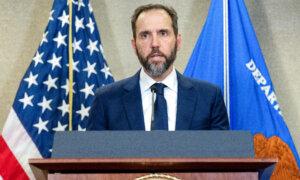The justices held in Fischer v. United States that the DOJ had applied an overly broad reading of a law used by the special counsel in his indictment of Trump.
Special counsel Jack Smith argued in a filing on Oct. 16 that former President Donald Trump should still face trial under an obstruction law even after the Supreme Court narrowed its meaning in a case decided this summer.
Only two of those counts were based on violations of the financial reform law, but Trump said that the Supreme Court’s logic “fatally undermine[d]” the other two counts as well. The dispute came during a delayed pretrial process that restarted after the Supreme Court’s immunity decision in July.
Trump’s arguments were part of a broader attempt to dismiss Smith’s case for statutory reasons while he also pursued a motion to dismiss based on presidential immunity. He’s expected to file another motion challenging the legitimacy of Smith’s appointment after Judge Aileen Cannon of the U.S. District Court for the Southern District of Florida cited that issue as a basis for dismissing Trump’s classified documents case.
In its Oct. 16 filing, Smith’s team accused Trump’s attorneys of ignoring the part of the indictment alleging that the former president tried to provide false evidence. “The Supreme Court explained that Section 1512(c)(2)’s criminal prohibition includes ‘creating false evidence,’” the special counsel’s filing read.
It added that a “federal grand jury subsequently returned a superseding indictment in this case that charged the defendant with the same offenses as the original indictment … including allegations that the defendant’s obstruction included the creation of false evidence, namely fraudulent electoral certificates.”
In the Supreme Court case, the justices heard an appeal from Joseph Fischer, who was at the Capitol on Jan. 6, 2021, but not involved in Trump’s alleged scheme to provide fraudulent electoral certificates to Congress. A majority of the justices held that the Department of Justice (DOJ) had applied the law in an overly broad way to Fischer.
Subsection (c)(1) starts with “alters” while subsection (c)(2) starts with “otherwise.”
The DOJ cannot, according to the Supreme Court’s majority, use a “catch-all” approach to interpreting (c)(2)’s prohibition against “otherwise” obstructing a proceeding. Instead, it must interpret that prohibition in reference to the preceding subsection, (c)(1), that discusses evidence impairment.
It clarified, however, that the DOJ’s application didn’t have to follow strictly the wording of the preceding subsection.
“It is possible to violate (c)(2) by creating false evidence—rather than altering incriminating evidence,” the Supreme Court said. “Subsection (c)(2) also ensures that liability is still imposed for impairing the availability or integrity of other things used in an official proceeding beyond the ’record[s], document[s], or other object[s]’ enumerated in (c)(1), such as witness testimony or intangible information.”
It added that because “these tasks were required by the ECA, actual or attempted transmission of alternate certificates did nothing to impair the integrity or availability of any certificates.”
Smith’s team responded by claiming that Trump’s brief “fundamentally misunderstands both the process by which electoral votes are counted and certified under the Constitution and the ECA and the fact that the incumbent President plays no role in that process.”
His brief also disputed the idea that the Supreme Court’s decision in Fischer should lead the court to dismiss other counts that utilized different laws.
Chutkan is expected to unseal additional evidence from Smith on Oct. 17; specifically, the appendix to his extensive briefing that used evidence to outline why the special counsel thought its indictment could survive under the Supreme Court’s immunity decision.
Original News Source Link – Epoch Times
Running For Office? Conservative Campaign Consulting – Election Day Strategies!


